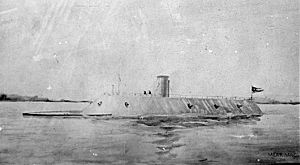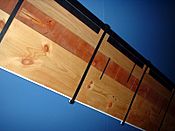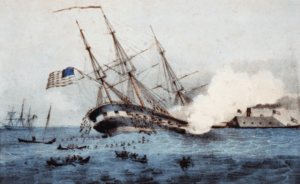CSS Virginia facts for kids
class="infobox " style="float: right; clear: right; width: 315px; border-spacing: 2px; text-align: left; font-size: 90%;"
| colspan="2" style="text-align: center; font-size: 90%; line-height: 1.5em;" | 
|} The CSS Virginia was a special warship built by the Confederate States Navy. It was the first steam-powered ironclad warship they made during the American Civil War. This ship was created from the remains of a sunken steam frigate called the USS Merrimack.
The Virginia became famous for its role in the Battle of Hampton Roads in March 1862. In this battle, it fought against the Union's own ironclad, the USS Monitor. This fight was very important in naval history. It was the first time two ironclad warships battled each other.
Contents
| History | |
|---|---|
| Name | CSS Virginia |
| Namesake | Virginia |
| Ordered | July 11, 1861 |
| Completed | March 7, 1862 |
| Commissioned | February 17, 1862 |
| Fate | scuttled May 11, 1862 |
| General characteristics | |
| Type | Casemate ironclad |
| Displacement | about 4,000 long tons (4,100 t) |
| Length | 275 ft (83.8 m) |
| Beam | 51 ft 2 in (15.6 m) |
| Draft | 21 ft (6.4 m) |
| Installed power | 1,200 ihp (890 kW) |
| Propulsion |
|
| Speed | 5–6 knots (9.3–11.1 km/h; 5.8–6.9 mph) |
| Complement | about 320 officers and men |
| Armament |
|
| Armor |
|
How USS Merrimack Became CSS Virginia
When the state of Virginia left the Union in 1861, a key federal naval base was in danger. This was the Gosport Navy Yard, now called Norfolk Naval Shipyard. Orders were given to destroy the base so the Confederates couldn't use it.
On April 17, the day Virginia left the Union, the frigate Merrimack was set on fire. It was then sunk to prevent its capture. When the Confederate government took over the yard, they decided to salvage the Merrimack. By May 30, the ship was pulled into a dry dock. The burned parts were removed.
The lower part of the hull and the engines were still in good shape. Stephen Mallory, the Confederate Secretary of the Navy, decided to turn the Merrimack into an ironclad warship. It was the only large ship with working engines available. Lieutenants John Mercer Brooke and John L. Porter drew up plans. They imagined the ship as a casemate ironclad, which means it had a sloped, armored structure. Brooke's design, which showed the front and back of the ship underwater, was chosen. Porter, a trained naval constructor, completed the detailed design.
Building the Ironclad Virginia
The burned wood of the Merrimack's hull was cut down. This left just enough room for its large, twin propellers. A new armored structure, called a casemate, was built on top of the main deck. A V-shaped breakwater was added to the front. This connected to the armored casemate.
The front and back parts of the main deck were designed to stay underwater. They were covered with 4-inch-thick (10 cm) iron plates. These plates were in two layers. The casemate itself was made of 24 inches (61 cm) of oak and pine wood. On top of this were two 2-inch (51 mm) layers of iron plating. These iron layers were angled at 36 degrees. This angle helped deflect enemy cannon shells.
The designers of the Virginia knew the Union was building an ironclad. They thought their cannons might not seriously damage such a ship. So, they decided to add a naval ram to the Virginia. This was an old-fashioned weapon for a 19th-century warship. The Merrimack's steam engines, now part of the Virginia, were not in great shape. They were supposed to be replaced before the Norfolk naval yard was abandoned.
The salty water of the Elizabeth River and the extra weight of iron armor made things worse. Tons of pig iron were also added for stability. This also helped submerge the unarmored lower parts of the hull. All this extra weight made the engines' job much harder. When finished, the Virginia needed about 45 minutes (2,700 s) to turn in a full circle. Its turning radius was about 1 mile (1.6 km). This slow turning would be a big problem when fighting the much faster Monitor.
The ironclad's casemate had 14 gun ports. Three were at the front and three at the back. One gun fired straight ahead or behind. The other two were angled at 45 degrees. These six gun ports had iron shutters to protect the cannons. There were four gun ports on each side, called the broadside. Their protective shutters were not installed during the Battle of Hampton Roads.
The Virginia's weapons included four muzzle-loading Brooke rifles. It also had six smoothbore 9-inch (229 mm) Dahlgren guns. These were saved from the old Merrimack. Two of the rifles, at the front and back, were 7-inch (178 mm) caliber. They weighed 14,500 pounds (6,600 kg) each and fired a 104-pound (47 kg) shell. The other two were 6.4-inch (163 mm) cannons, one on each side. They weighed about 9,100 pounds (4,100 kg). The 9-inch Dahlgrens were three on each side. Each weighed about 9,200 pounds (4,200 kg). They could fire a 72.5-pound (32.9 kg) shell up to 3,357 yards (3,070 m). The Dahlgrens near the boiler furnaces could fire heated shot. On the upper deck of the casemate, there were two 12-pounder Howitzers. These were used to defend against enemies trying to board the ship.
Flag Officer Franklin Buchanan became the Virginia's commanding officer. He arrived just a few days before its first mission. The ship was made ready by its executive officer, Lieutenant Catesby ap Roger Jones.
The Battle of Hampton Roads
The Battle of Hampton Roads started on March 8, 1862. The Virginia sailed into Hampton Roads to fight the Union fleet. Even though it was not fully finished, the ironclad had workers still on board. It was joined by five support ships.
The first Union ship the Virginia attacked was the USS Cumberland. This ship was made of wood and used sails. The Virginia first damaged it with cannons. Then, it rammed the Cumberland in the front. As the Cumberland sank, part of the Virginia's iron ram broke off. This caused a leak in the ironclad's front.
Seeing this, the captain of the USS Congress moved his ship into shallower water. But it soon got stuck. The Congress and Virginia fought with cannons for an hour. The damaged Congress finally gave up. While the crew of the Congress were leaving, a Union battery on shore fired at the Virginia. This made the Virginia's captain, Commodore Franklin Buchanan, very angry. He ordered his crew to fire hot-shot at the surrendered Congress. He was then injured by enemy rifle fire. The Congress caught fire and burned for hours. It showed how powerful the Confederate navy was. It was also a warning to the Union's wooden ships.
The Virginia was also damaged. Its anchor was lost after ramming the Cumberland. The front of the ship was leaking. Shots from the Cumberland, Congress, and shore batteries hit its smokestack. This made its engines even slower. Two of its side cannons were broken. Some of its armor plates were loose. Both of its small boats were shot away. Most of the deck supports and railings were also gone. Even so, the injured Buchanan ordered an attack on the USS Minnesota. This ship had run aground trying to escape. However, the Virginia could not get close enough. Its deep draft (how deep it sits in the water) prevented it. Since it was late, the Virginia left. It planned to return the next day to finish off the Union ships.
Later that night, the USS Monitor arrived at Fort Monroe. It had been rushed from the Brooklyn Navy Yard. It was not quite finished. The Monitor was sent to defend the wooden ships. It also aimed to stop the "rebel monster" from threatening Union cities like Washington, D.C.. On its way south, it almost sank twice in storms. It arrived in Hampton Roads, guided by the fire from the still-burning Congress.
The next day, March 9, 1862, the world saw its first battle between ironclads. The smaller, faster Monitor could move around the larger, slower Virginia. But neither ship could seriously damage the other. They fired many shells at very close range. The Monitor sat lower in the water. Only its rotating gun turret and front pilothouse were above deck. This made it much harder for the Virginia's cannons to hit.
After hours of fighting, the Monitor moved into shallower water. A direct hit to its armored pilothouse forced it away. The Monitors captain, Lieutenant John Lorimer Worden, was blinded. He was looking through the pilothouse's narrow viewing slits when a gunpowder explosion happened. The Monitor stayed in the shallow water. But it was late in the day. The Virginia headed back to its home port. The battle ended with no clear winner. The Virginias captain, Lieutenant Catesby ap Roger Jones, was advised to leave. The pilots said the Virginia had "nearly three miles to run to the bar." They said it could not stay and get stuck on a falling tide. So, Lieutenant Jones sadly moved the ironclad back to port. The Virginia went to the Gosport Naval Yard for repairs. It stayed there until April 4, 1862.
In the next month, the Virginia's crew tried to break the Union blockade. But the blockade was stronger now. The Union had added more ships, including the USS Vanderbilt and the repaired USS Minnesota. The Virginia went out several times, hoping to fight the Monitor. However, the Monitor had strict orders not to fight again. The two famous ironclads never battled each other again.
On April 11, the Confederate Navy sent the CSS Jamestown and five other ships with the Virginia. They sailed in full view of the Union squadron. They hoped to make them fight. When it was clear the Union ships would not fight, the Confederate squadron captured three merchant ships. They were the brigs Marcus and Sabout and the schooner Catherine T. Dix. Their flags were flown upside down to tease the Union Navy. They were then towed back to Norfolk.
By late April, new Union ironclads had joined the blockade. On May 8, 1862, the Virginia and the James River Squadron sailed out. Union ships were shelling Confederate forts near Norfolk. But the Union ships retreated under the protection of shore batteries.
The End of CSS Virginia

On May 10, 1862, Union troops took over Norfolk. The Virginia was a heavy floating battery, not a ship for the ocean. Its pilots thought it was not safe enough to go into the Atlantic. It also could not go further up the James River because it sat too deep in the water. Its draft was 22-foot (6.7 m). To make it lighter, supplies and coal were thrown overboard. But this was not enough.
Without a home port and nowhere to go, the Virginia's new captain, flag officer Josiah Tattnall III, sadly ordered its destruction. This was to keep the ironclad from being captured. Lieutenant Jones was in charge of this task. He was the last person to leave the Virginia. Its cannons had been safely removed and taken to a Confederate base. Early on May 11, 1862, near Craney Island, fire and powder reached the ship's magazine. The Virginia was destroyed by a huge explosion. What was left of the ship sank to the bottom of the harbor. Only a few parts of the Virginia have been saved for museums. Reports from that time say its wreck was heavily salvaged after the war.
The Monitor was also lost later that year, on December 31. It sank in a violent storm while being towed by the tugboat USS Rhode Island. This happened off Cape Hatteras, North Carolina. Sixteen of its 62 crew members were lost. Many others were saved by lifeboats from the Rhode Island. In 1973, the wreckage was found on the ocean floor. Years later, its upside-down turret was raised. The remains of two crew members were still inside. They were buried with full military honors on March 8, 2013, in Arlington National Cemetery.
Names: Merrimack, Virginia, Merrimac
Even though the Confederacy renamed the ship, many people still call it by its Union name. When it was first used by the United States Navy in 1856, its name was Merrimack, spelled with a 'K'. This name came from the Merrimack River where it was built. It was the second U.S. Navy ship named after this river.
After being raised and rebuilt as an ironclad, the Confederacy named it Virginia. But the Union kept calling it Merrimack or "The Rebel Monster." After the Battle of Hampton Roads, both names were used. Newspapers and letters from that time show this. Navy reports and historians before 1900 often misspelled the name as "Merrimac." This was actually a different ship. So, people sometimes called it "the Battle of the Monitor and the Merrimac." Both spellings are still used in the Hampton Roads area today.
Remembering the Virginia
- At the Jamestown Exposition in 1907, there was a big exhibit. It was called the "Battle of the Merrimac and Monitor." It was a large diorama inside a special building.
- A small town in Montgomery County, Virginia, is now called Merrimac. This is near where the coal burned by the ironclad was mined.
- In 1867, the Norfolk Virginian newspaper had an ad for the salvaged iron ram of CSS Virginia. It said:
A RELIC OF WAR FOR SALE: The undersigned has had several offers for the IRON PROW! of the first iron-clad ever built, the celebrated Ram and Iron Clad Virginia, formerly the Merrimac. This immense RELIC WEIGHS 1,340 POUNDS, wrought iron, and as a sovereign of the war, and an object of interest as a revolution in naval warefare, would suit a Museum, State Institute, or some great public resort. Those desiring to purchase will please address D. A. UNDERDOWN, Wrecker, care of Virginian Office, Norfolk, Va.
- It's not clear if this was the first ram that broke off during the battle. Or if it was the second ram on the Virginia when it was destroyed. No more information has been found about what happened to this piece of history.

- Other parts of the Virginia still exist. They are on display at the Mariners' Museum in Newport News. One of its anchors is on the lawn of the American Civil War Museum in Richmond.
- In 1907, an armor plate from the ship was melted down. It was used to cast the Pokahuntas Bell for the Jamestown Exposition.
- Starting around 1883, many souvenirs were made from the Virginia's sunken remains. These were made from salvaged iron and wood. People on the eastern seaboard who remembered the battle bought them. Tokens, medals, and other metal items were made. Some examples still exist in collections today.
- The Monitor–Merrimac Memorial Bridge–Tunnel in Hampton Roads is named after the famous battle. It was built with money from Virginia and the federal government.
Images for kids
-
CSS Virginia. The image is captioned Merrimac; see below.
-
Destruction of the rebel vessel Merrimac off Craney Island, May 11, 1862, by Currier and Ives.
-
This is an anchor from CSS Virginia. It used to be at the American Civil War Museum.
See also
 In Spanish: CSS Virginia para niños
In Spanish: CSS Virginia para niños












